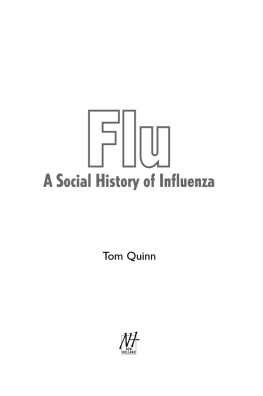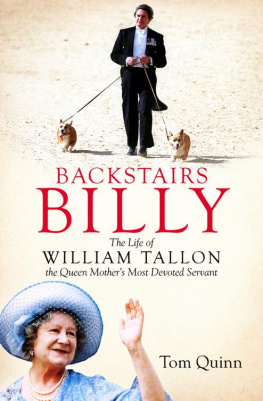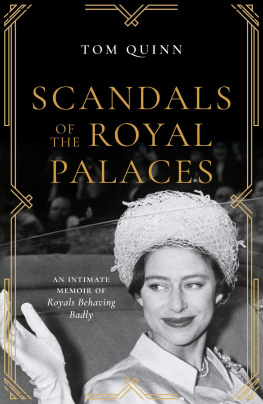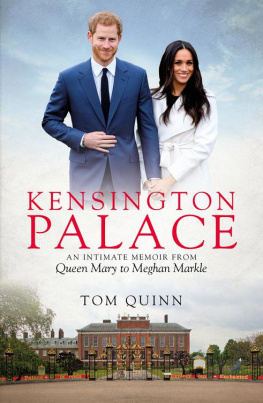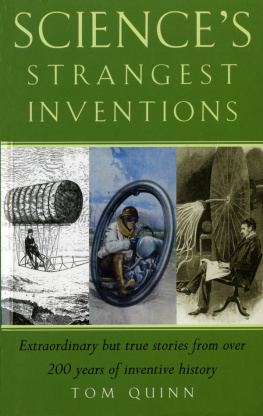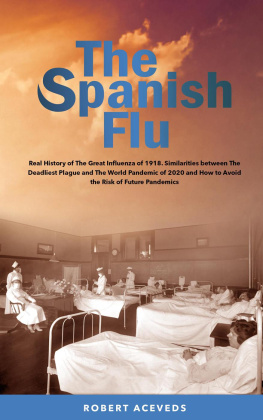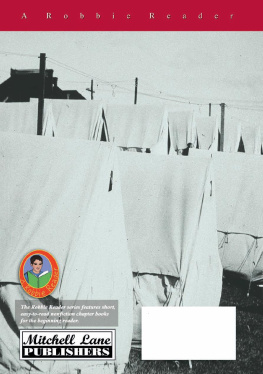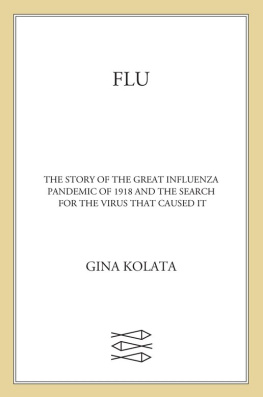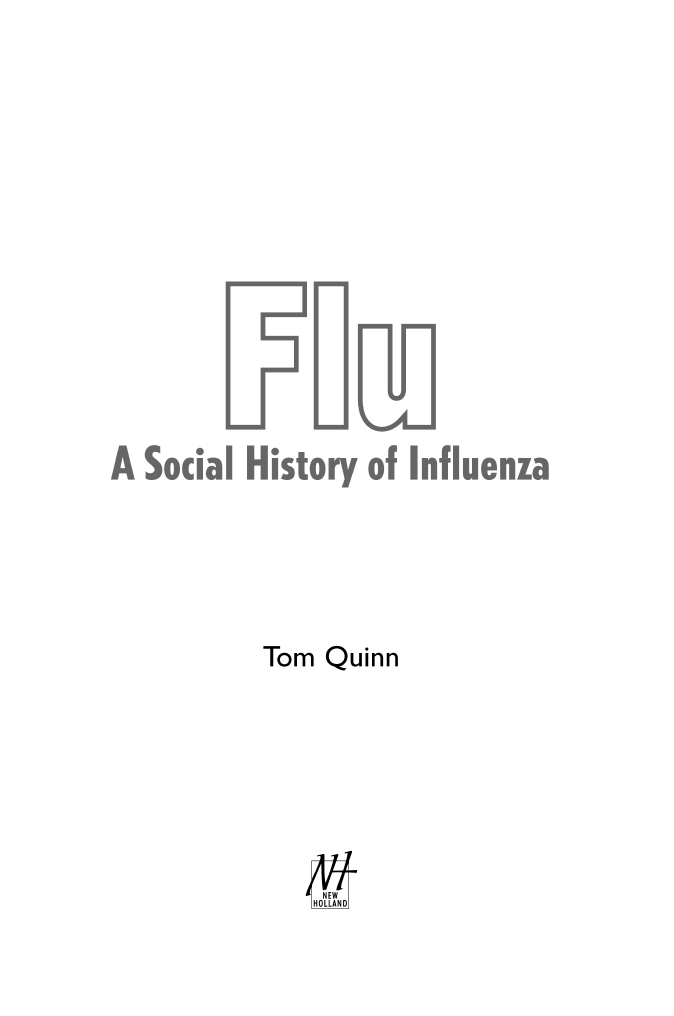Tom Quinn is a journalist and social historian.
The author of more than 30 books, including
Britains Best Historic Sites (New Holland, 2011),
Tom is also the of Country Landowner magazine.
A Social History of Influenza
Tom Quinn
This edition published in 2011
Printed edition first published in 2008 by New Holland Publishers (UK) Ltd
London Cape Town Sydney Auckland
www.newhollandpublishers.com
Garfield House
8688 Edgware Road
London W2 2EA
United Kingdom
80 McKenzie Street, Cape Town 8001, South Africa
Unit 1, 66 Gibbes Street, Chatswood, NSW 2067, Australia
218 Lake Road, Northcote, Auckland, New Zealand
Text copyright 2011 Tom Quinn
Copyright 2011 New Holland Publishers (UK) Ltd
Tom Quinn has asserted his moral rights to be identified as the author.
All rights reserved. No part of this publication may be reproduced, stored in a retrieval system or transmitted, in any form or by any means, electronic, mechanical, photocopying, recording or otherwise, without the prior written permission of the publishers and copyright holders.
ISBN: 978 1 84537 941 4 [Print]
ISBN: 978 1 78009 106 8 [ePub]
ISBN: 978 1 78009 107 5 [Pdf]
Publisher: Aruna Vasudevan
Senior Editor: Kate Parker
Design and cover design: Peter Crump
Production: Melanie Dowland
Note: The author and publishers have made every effort to ensure that the information given in this book is safe and accurate, but they cannot accept liability for any resulting injury or loss or damage to either property or person, whether direct or consequential and howsoever arising.
To Wado
Contents
Acknowledgements
The greatest part of a writers time is spent in reading, in order to write; a man will turn over half a library to make one book.
When Samuel Johnson wrote that, 250 years ago, he was certainly thinking of libraries containing at most a few tens of thousands of volumes. Today, the author is faced with the prospect of turning over far more books not to mention magazines and journals than ever before, particularly if he is treading a well worn path.
Writing this book presented a curious mix of problems specialist journals are a rich source of material about flu and viruses in general but they do not touch on the social aspects of disease or if they do it is only, as it were, incidentally. Similarly, books with a few notable exceptions tend to concentrate on the scientific aspects of influenza. The history of influenza as it affected individual lives is much harder to come by, especially when it comes to primary material the nitty gritty of real lives reported in real time. Given that difficulty it has to be said that this book would hardly have got off the ground without the generous assistance of a large number of individuals and organizations, but particularly specialist libraries.
We tend to forget that libraries specialist libraries would not and could not function without the skills of the staff who run them. Books and journals may be available for all in these institutions but it is the librarians who provide the route map that makes any major collection of material genuinely accessible. Their efforts on behalf of specialist researchers usually go unnoted and unsung. My own experience in a number of libraries across the UK and elsewhere reminds me that few books apart perhaps from works of fiction would reach the booksellers shelves without the efforts of these individuals who work in obscure corners yet provide enormously helpful advice to anyone who needs their help. Authors draw hugely on the experience and knowledge of librarians to short circuit what might otherwise be a long and tedious journey towards the right journal, the appropriate reference work. At the same time librarians tend to be a rather selfeffacing lot, which may be why those who gave me the most help tended to be least keen on being publicly thanked. So without mentioning them by name Id like to thank all those librarians who pointed me in the right direction or saved me from obvious blunders and fruitless searches.
One of the most extraordinary things about writing a book such as this is that the process of research brings one not into the dry history of kings and queens, of impersonal and imperial development, but rather gives one a rare glimpse into the personal everyday lives of long vanished individuals. These individuals left no great monuments but took part in, or were victims of, some of the most exceptional events of the past century and more.
Without the personal testimony of survivors of, for example, the great flu pandemic of 1918-19, a book such as this would not be possible. It must have been immensely painful for the survivors of families almost wiped out by Spanish flu to recall again for contemporaneous researchers the horror of those days, but their memories have helped scientists, medical researchers and historians immeasurably. I would like to thank those descendants of survivors who were unfailingly patient and polite in the face of what must have sometimes seemed an endless stream of enquiries from me. They were also diligent in answering my often lengthy letters.
In earlier centuries many doctors, struggling with the weight of history and their own inadequate equipment, were also prepared to spend a great deal of time writing in journals and in letters to colleagues. These accounts frequently contain remarkable detail on patients symptoms, the progress of the disease and their own attempts, however futile, to cure the sick.
Doctors were particularly good correspondents and much of what they wrote survives in record centres and libraries up and down the country finding ones way through these documents is a nightmare for the uninitiated and I would like to thank a number of individuals including Tom Pike, Tim Kehoe, Andrew Hall and Pietro Lampedusa for helping me through a mountain of documents.
I would also like to thank a number of living doctors who didnt hesitate to share their expertise and knowledge of influenza particularly avian influenza with a layman.
Virologist Patricia Davis deserves a huge thank you for carefully reading the book and rescuing me from numerous foolish errors of both emphasis and fact. Errors and misjudgments that remain are, of course, all my own.
For help with practical, emotional, logistical and general historical matters Id also like to thank Wado Wadham, Barbara OFlaherty, Richard Jarman, Karen Warren, Faith Glasgow, Sarah Storey, Juliet Quick, Mr Scrivens, Deborah Fisher, Mary Corbett, Eric Gray, Mr Busby, Rachel Lennox, Richard Smith, The Latimer Road Fishing Club, Tom Marmoset, Lol Plummer, Louise Davies, Lord Sharpe of Bromley, The Hon Mel Capper, Nicola Bird, Emma Westall, Katy Quinn Guest, Alexander Quinn Guest, James Quinn Guest, the late Deborah Anne Quinn, Jessie Cooke, Nina Porter, Sara Doak, Corinna Marshall, Jane Smith, Robert Pike, Frances Jackman, Julian Bell, Jane Simms, Minky, Mona and Captain Swing.
If I have missed anyone in my relatively restrained list above, Im sure they will understand but to what might best be termed the inner circle that is, my children and partner Charlotte not to mention Londons most intelligent dog, Nutmeg Id like to say an extra thank you.

